
Kwaeε is a pyramidical timber pavilion in the Venice Arsenale. According to its architect Adjaye Associates it acts as an inverted sun dial. Photography by Andrea Avezzù courtesy of Venice Architecture Biennale.
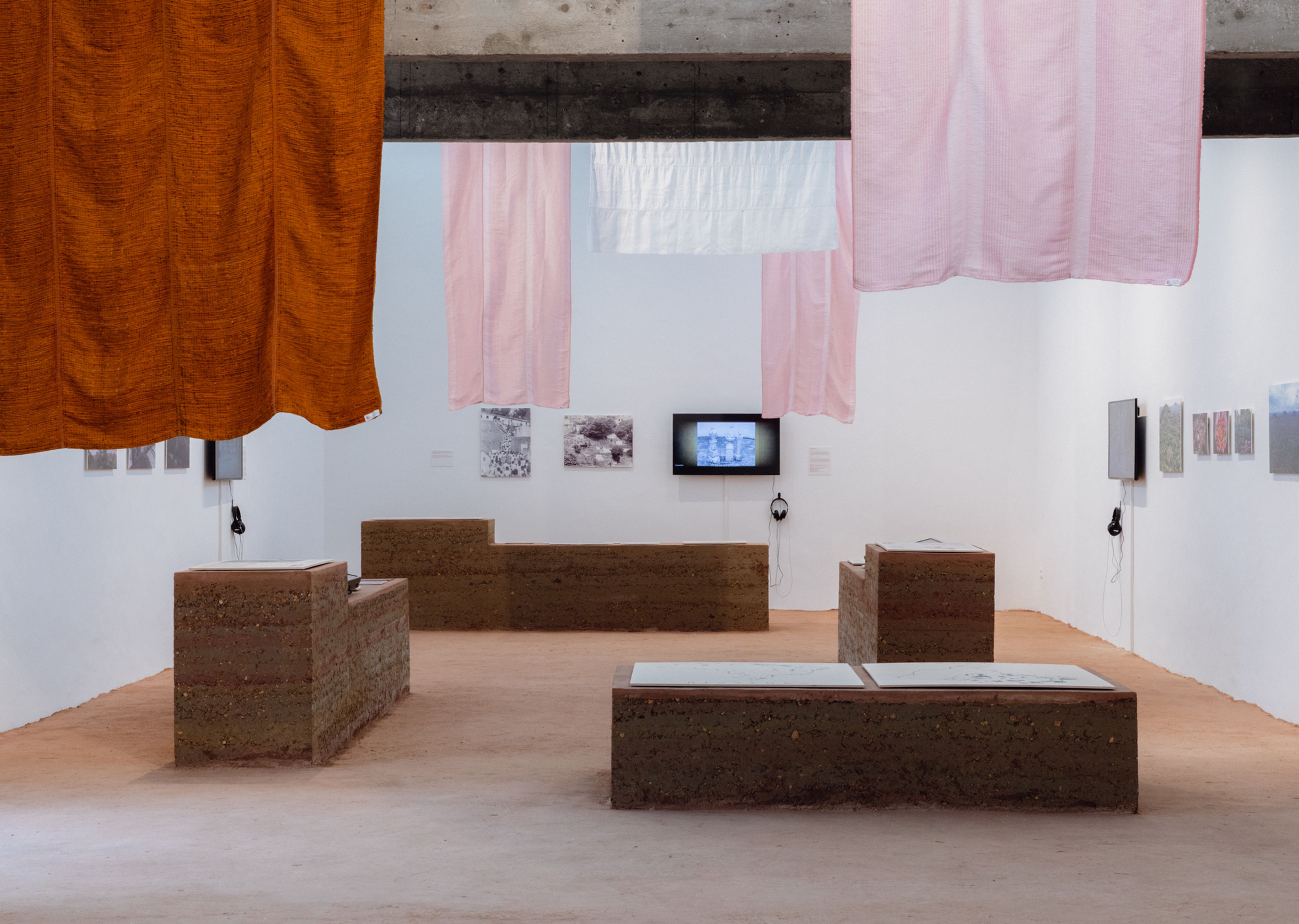
The exhibition Terra, curated Gabriela de Matos and Paulo Tavares for the Brazil national pavilion, took home the Golden Lion at the 2023 Venice Biennale of Architecture. Photography by Matteo de Mayda.
This year's 18th Biennale di Architettura in Venice, which opened May 20, 2023, centers for the first time on Africa and the African diaspora. Curator Lesley Lokko’s surprisingly upbeat edition positions the continent as the source of potent, alternative ideas for global architecture and urbanism. The show asks us to dream about a future with two vital outcomes: decolonization and decarbonization. No small order. But as Lokko puts it in the Biennale’s introduction text, “it is impossible to build a better world if one cannot first imagine it.” Unlearn the classic bounds of architecture, the exhibition whispers, and let the visioning begin.

Architectural academic, educator, and best-selling novelist Lesley Lokko is the curator of the 2023 Venice Biennale of Architecture. Portrait by Debra Hurford-Brown
For a biennale titled Laboratory of the Future, there is little to see in terms of cutting-edge technology or, for that matter, buildings. Out are big firms and slick installations. Instead, Lokko gathers an impressively young cadre of exhibitors that intentionally broadens conceptions about who should be at the architects’ table. Two videos looping in the pitch-dark opening halls of the Arsenale and the Giardini herald an exhibition-wide reorientation of value that puts storytelling and pre-colonial modes of building and living together first. In one, David Adjaye, likely the most prominent contributor this year, embraces “lost knowledge systems” in a four-part video exploring indigenous construction techniques from his native Ghana. In the other, LionHeart, a spoken word artist from London, intones that “if architecture doesn’t serve feelings it serves a psychosis.” Thankfully, Lokko’s assemblage of new voices — heavy on design as social practice and vibey films — certainly serves feelings, with a palpable sense of optimism and history-in-the-making coursing through the biennale grounds. The exhibition also serves up powerful critiques of the extractive and violent underpinnings of Western architectural practice past and present.

Kwaeε is a pyramidical timber pavilion in the Venice Arsenale. According to its architect Adjaye Associates it acts as an inverted sun dial. Photography by Andrea Avezzù courtesy of Venice Architecture Biennale.
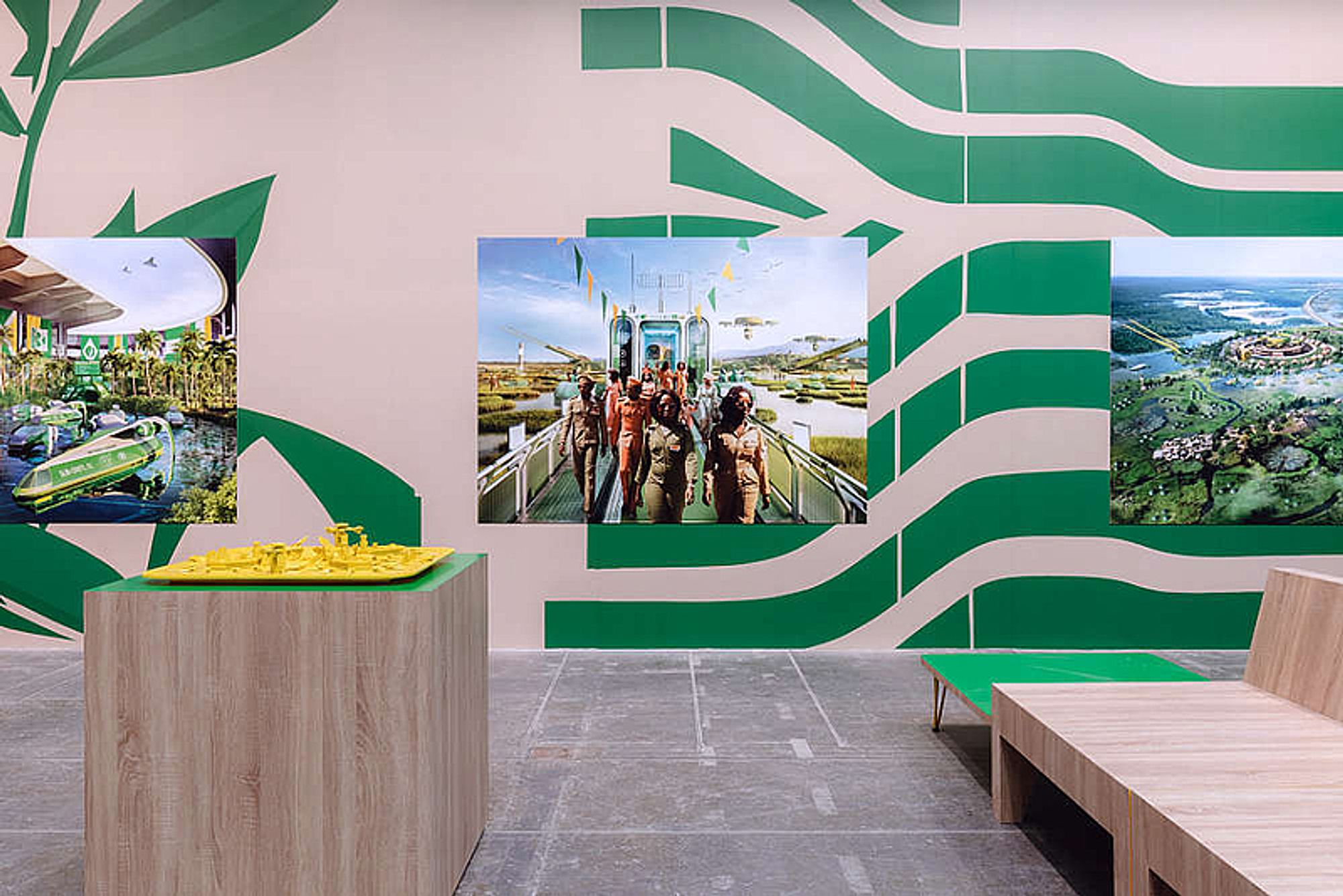
Detail view of Nigerian-American artist Olalekan Jeyifous’s All-African Protoport, a mock departure lounge for an eco-futurist, pan-African transport network. Photography by Matteo de Mayda courtesy of Venice Architecture Biennale.
While eschewing the term Afrofuturism, a surprising number of works in the main exhibition engage in speculative fiction. Robots of Brixton, a sci-fi style video tucked into the back of the Central Pavilion, offers a hard-to-follow “narrative exploration into counterfactual pasts and hypothetical futures” of a dystopian pseudo-London riven by police brutality and racism — much like reality. One of the most memorable and centrally placed works is Nigerian-American artist Olalekan Jeyifous’s All-African Protoport, a mock departure lounge for an eco-futurist, pan-African transport network replete with zero-emission hovercrafts and chic mid-century fashion. Weirder still is a video by Grandeza Studio in the Arsenale that follows a squad of eco-warriors in space helmets and balaclavas chanting about rare earth mineral mining in Western Australia. The video shines a timely spotlight on the destructive “green gold rush,” a recurrent topic elsewhere in the biennale. There’s also Liam Young’s Great Endeavor, an apocalyptic geoengineering wet-dream to “decolonize the atmosphere” of carbon. Whether playful or bleak, the speculative narratives peppered throughout the biennale seem to tease the techno-utopians and Rem Koolhaas-es of the world: maybe it’s time for a rethink.
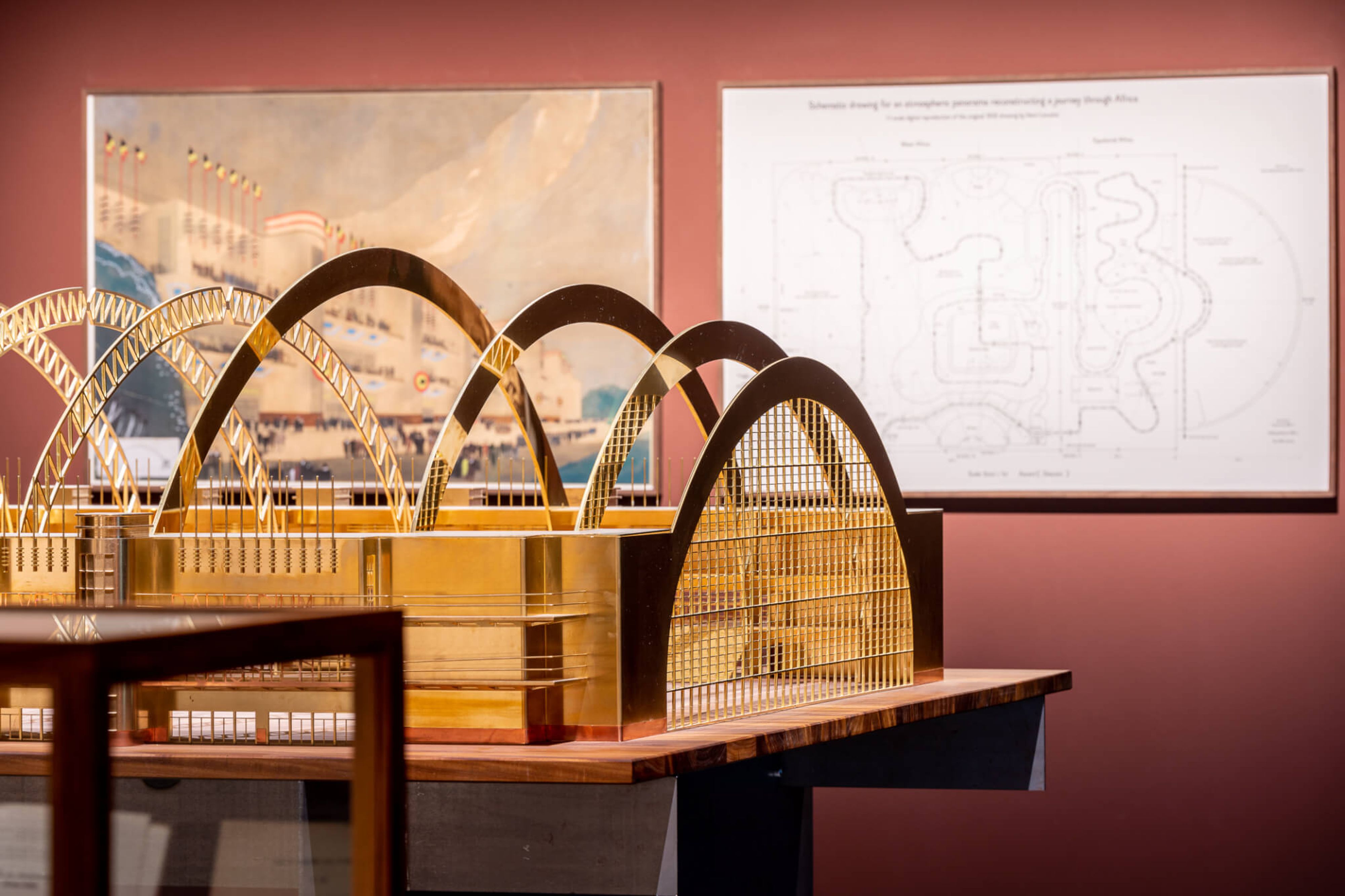
Detail view of Aequare: the Future that Never Was, an exhibition by Congolese artist Sammy Baloji and Twenty Nine Studio, the research company he founded with Rosa Spaliviero. Photography by Andrea Avezzù courtesy of Venice Architecture Biennale.
Despite this tendency, many of the most compelling contributions ground their implicit critique of Western archi-capitalism in research and materiality rather than fiction. Sammy Baloji’s film Aequare: the Future that Never Was melds colonial-era promotional reels on agricultural and mineral exploitation in his native Congo with contemporary footage of similar practices. Nearby, he constructs a stunning brass and copper replica of an exhibition hall from the 1935 Brussels World’s Fair celebrating Belgian colonialism. Dubbing it the “Extraction Pavilion,” Baloji cleverly updates the signage on the sides of the model to advertise resource extraction du jour: Platinum, Cobalt, Lithium. Further down the Corderie, visitors confront another outstanding Baloji work: a rough-yet-dazzling tapestry of brick and glass, imagined alongside Gloria Cabral and Cécile Fromont. Built with construction debris found in Brussels, Congo’s former metropolis, the wall obstructing the Arsenale passage is a simple, robust emblem for how the discarded remnants of colonialism can be remade into something unexpectedly beautiful. Another standout contributor is Paulo Tavares and Gabriela de Matos with their research into the erasure of indigenous communities at the heart of Brazil’s nation building project — a topic they compellingly explore in both the Arsenale and with their Golden Lion-winning Brazilian Pavilion.
Even the most forensic of practices couldn’t resist Lokko’s call for imagination. In an installation building off David Wengrow and David Graeber’s smash hit book Dawn of Everything, Eyal Weizman and Wengrow posit The Nebelivka Hypothesis. In a darkened room, archeological maps of a 6,000-year-old Ukrainian settlement are projected onto the floor. “If these ancient Ukrainian sites are cities,” Wengrow and Weizman argue, “then our concept of ‘the city’ as rooted in a history of extraction, predation and hierarchy must also change.” It is a big if, but one that certainly resonates with the rest of the exhibition.
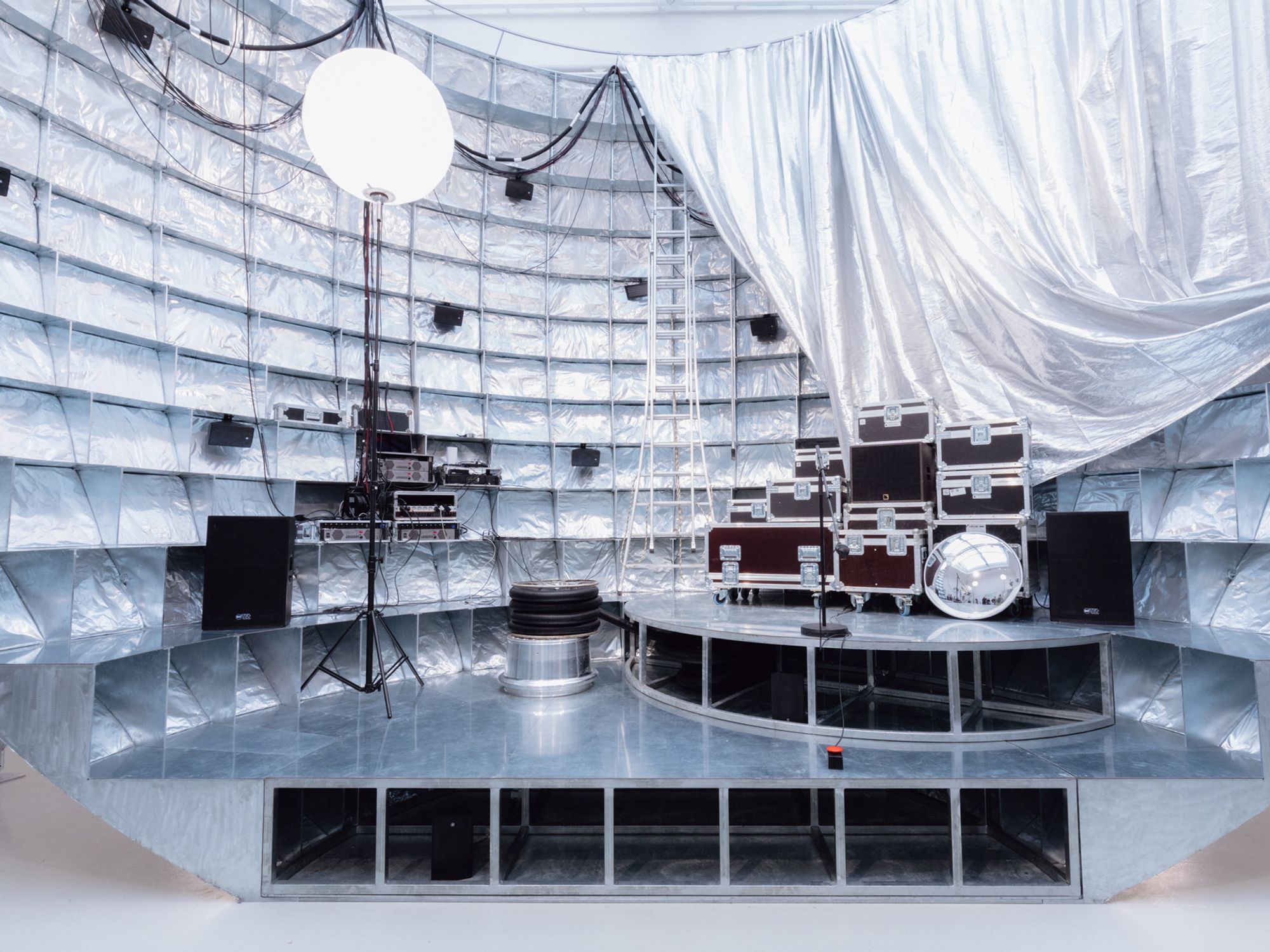
Ball Theater in the French Pavilion was curated by Muoto & Georgi Stanishev. The installation functions as a performance stage that embraces queer subculture. Photography by Matteo de Madya.
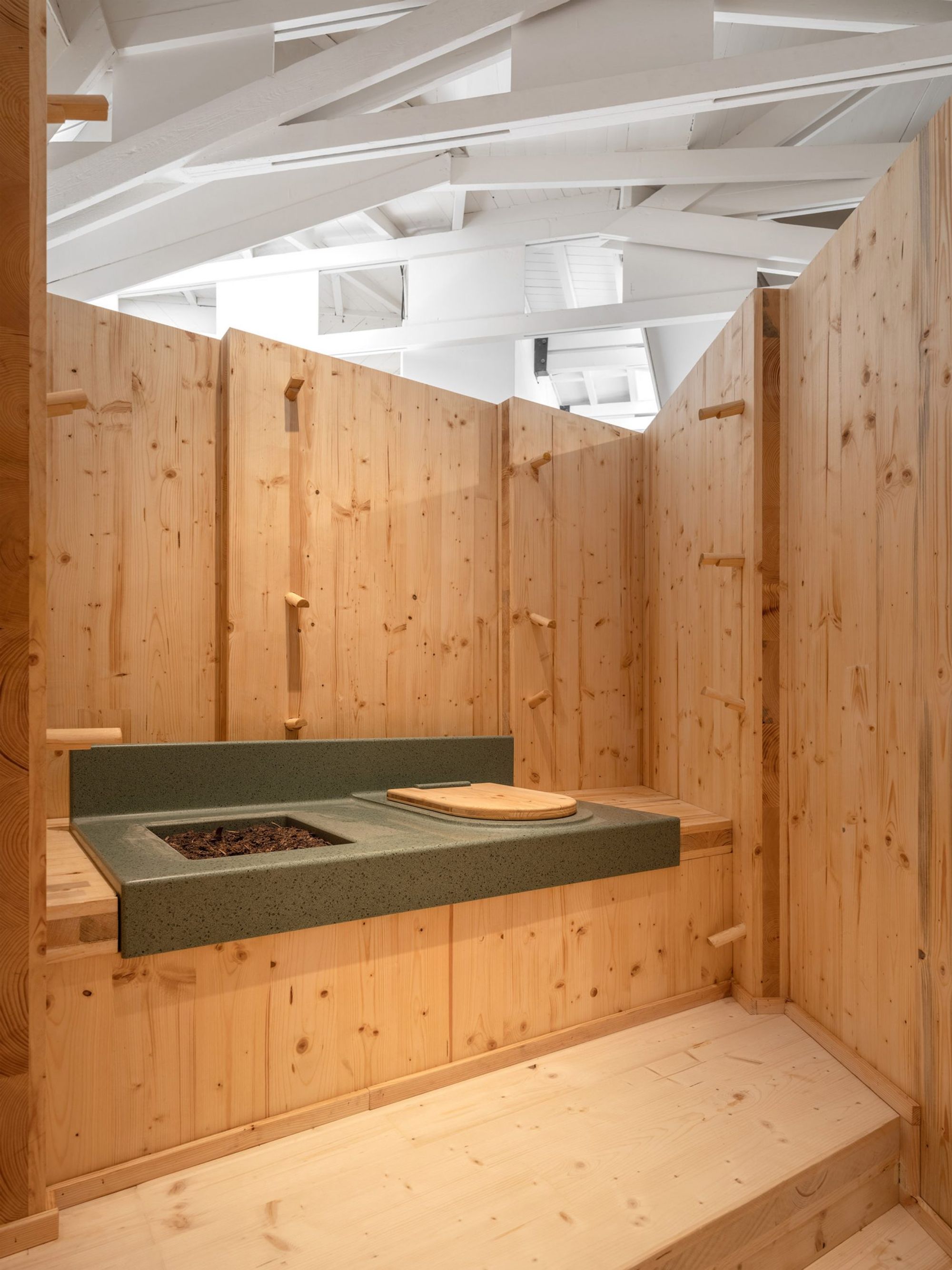
The Finnish pavilion, curated by Arja Renell, proposes the huussi, an environmentally-friendly composting toilet common in the Finnish backwoods. Photography by Ugo Carmeni

The curators of the 2023 British Pavilion, from left to right: Jayden Ali, Meneesha Kellay, Sumitra Upham and Joseph Henry. Photography by Taran Wilkhu courtesy of British Council.
Among the national pavilions, responses to Lokko’s decolonial, decarbonizing provocation were alternatingly self-reflective and navel-gazey. Britain and France lovingly embraced immigrant and queer subcultures within. While the empty disco ball structure and strewn paraphernalia of a drag queen in the French pavilion feel more gestural, the captivating British pavilion packs in eye-catching sculptural work and a film compilation saluting cultural symbols — dominos, hair salons, and tricked-out cars — of the UK’s diverse minority communities. The young British curatorial team also threw the best party of opening week, partnering with a local soundsystem collective on a late-night banger in a deconsecrated Venetian church. The Nordic countries also took up the decolonial spirit, looking northwards to the architectural practices of their own indigenous Sámi people. The comfy result — reindeer fur, patterned cloths, and wooden structures to lounge on and in, created by Joar Nango — is stunning. The Italian Pavilion, normally a stodgy affair, matches the youthfulness of the main exhibition with an energizing showcase (curated by Fosbury Architecture), of nine site-specific interventions by small firms around Italy under the future-forward banner “everyone belongs to everyone else,” aptly quoted for this year’s themes from Aldous Huxley’s Brave New World. Finland adds a welcome dose of humor and practicality to the mix, calling for the “death of the flush toilet” — including a gravesite for it outside the Aalto-designed pavilion — in favor of the more environmentally-friendly huussi, a composting toilet common in the Finnish backwoods.
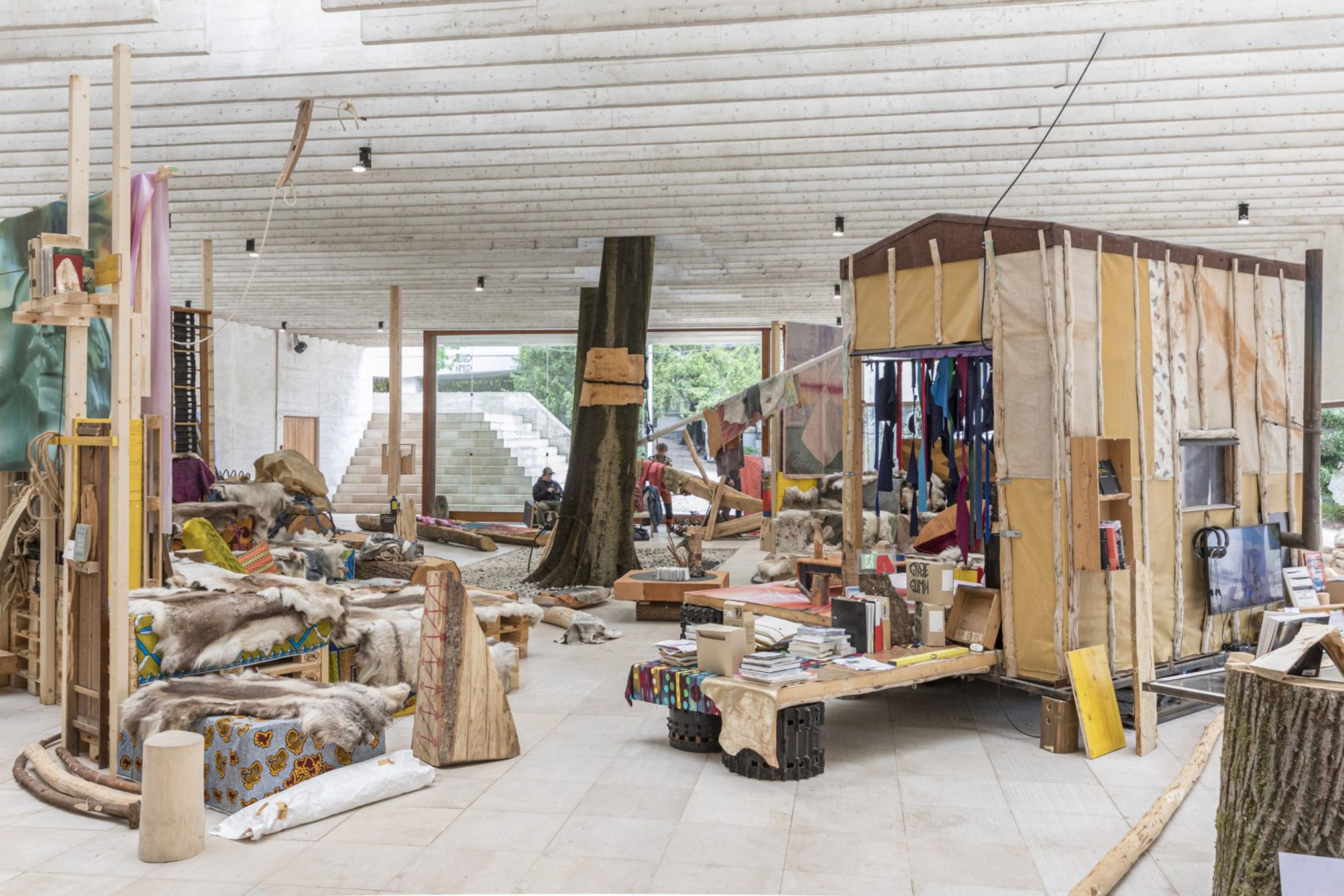
Interior of the Nordic Pavilion with a library designed by Samí artist and architect Joar Nango. Photography by Laurian Ghinitoiu.
Other European countries couldn’t resist the temptation, yet again, to obsess over their own pavilions. The Dutch built a rainwater system on their roof. Germany embraces the concept of “maintenance,” transforming their pavilion into a warehouse of leftover materials from previous biennales and a staging ground for the reconstruction of local housing. Compared to the sad QR-codes-on-blank-walls of Germany’s previous edition, this year is active and useful. Austria, in a performative gesture to “decolonize” the relationship between the gated biennale and its Venetian neighbors, proposed building a bridge from its back garden to the adjoining neighborhood knowing full well that the plan would be rejected. On a similar note, the Swiss entry Neighbors tore down the wall separating its Bruno Giacometti-design pavilion from Carlo Scarpa’s stunning Venezuelan pavilion next door. The act celebrates the “spatial and structural proximity between the Swiss and its Venezuelan neighbor,” fueled by the real-life friendship of the two dead European designers. In telling contrast, the on-life-support Venezuelan contribution features a display, only in Spanish, detailing the social and spatial impact of Carlos Raúl Villaneuva’s mid-century Ciudad Universitaria in Caracas. While the Swiss curators pat themselves on the back for “dissolving borders” within the Giardini, their counterparts still approach architecture in 20th century modernist terms where buildings have the power to educate and uplift.
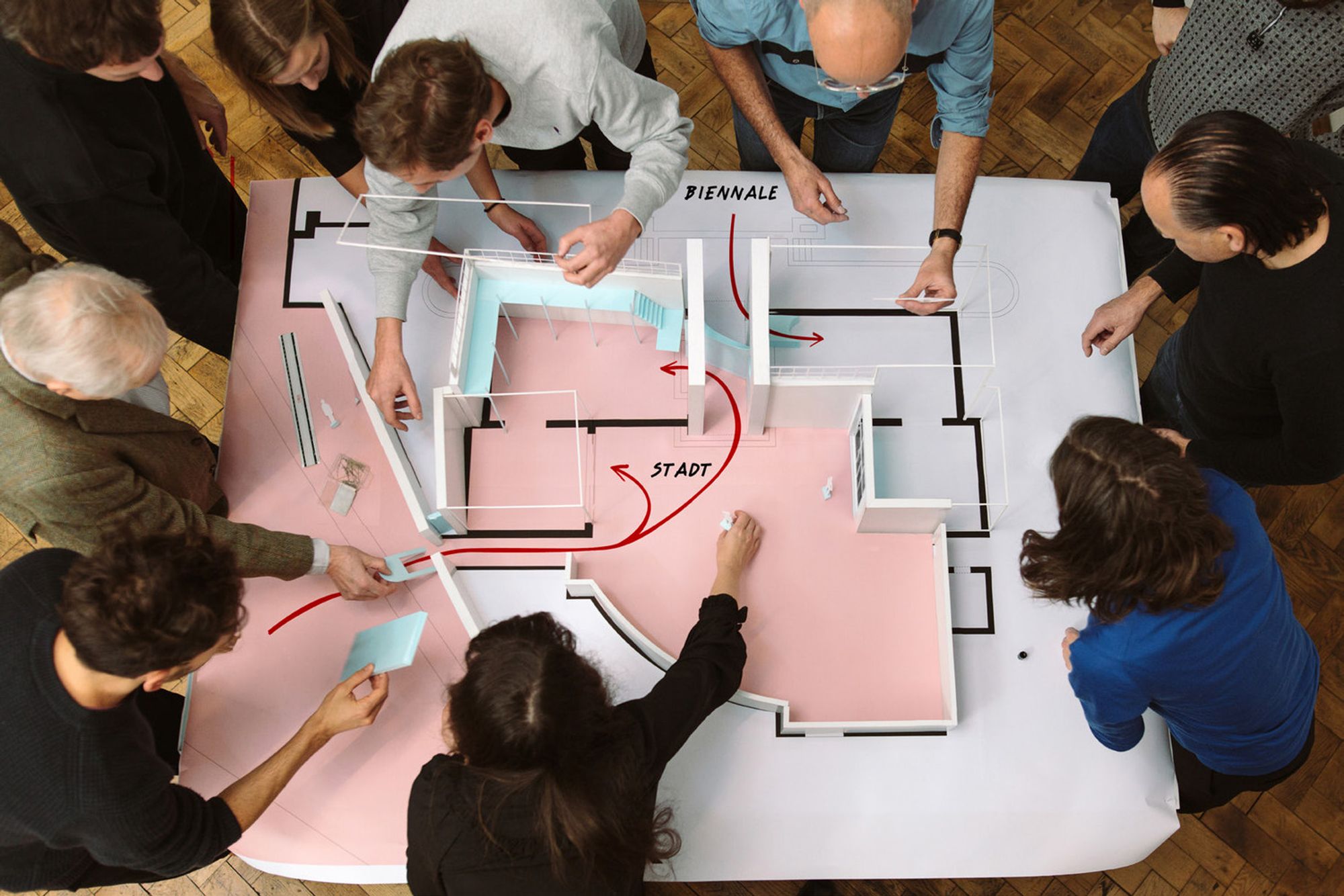
Partecipazione/Beteiligung is AKT collective and Hermann Czech's design for Austria's pavilion at the Venice Biennale. The proposal included a bridge from the pavilion's back garden to the adjoining neighborhood. Photography by Theresa Wey.

Switzerland’s pavilion is curated by Karin Sander and Philip Ursprung. It focuses on the spatial and structural proximity between the Swiss Pavilion and its Venezuelan neighbor, designed by Bruno Giacometti and Carlo Scarpa respectively. Photography by Matteo de Mayda.
Meanwhile, in the main exhibition, Lokko looks ahead, gathering a “group of practitioners busy redefining the role and scope of the architect in the 22nd century.” With its diverse roster and expansive focus, Lokko undoubtedly succeeds in subverting architecture-world gatekeeping. Yet, imagination alone won’t design buildings, pour concrete and lay pipes for the fastest urbanizing continent on earth. Voiceless laborers and powerful figures — foreign financiers, corrupt officials, and yes, architects — will. Despite its laudable, genuine focus on Africa, the biennale skirts consideration of certain structural realities that define African cities, including debt-fueled Chinese and Western mega-projects. Entering a room full of models of Adjaye Associates’ latest projects in the Central Pavilion feels like a refreshing aha moment. Finally, buildings! Unfortunately, the immaculate displays are not matched by critical analysis of these large-scale projects, like the oil-money Africa Institute in Sharjah or the National Cathedral in Ghana, considered by many locals to be a political white elephant.
Interestingly, the biennale’s weaknesses — at times under-resourced and lacking in clear curatorial structure — serve to underline a critique of global power that Lokko set out to make. “Throughout the Exhibition, the contrast between participants from countries with generational means and those without is stark,” she writes in the introduction. “Systematic resource inequality requires systematic change.”

The Latvian pavilion was transformed into a faux supermarket with a seductive yet cynical display of products with AI-generated names based on architecture jargon. Photography by Matteo de Mayda.
One of the most talked-about pavilions this year is the highly instagrammable Latvian entry which trained AI on the curatorial word salad of pavilions past to create a faux supermarket of architectural ideas. In the seductive but cynical display, you fill your cart with commodified versions of what now read like broken promises: a cardboard cut-out juice carton — origin Brazil — labeled “Next Cities: Cities without Favelas!”. Or don’t forget the Israeli yogurt with the sickening brand name “Border Disorder.” Will this biennale’s worthy aims hit the shelves next year? I hope not.

The Floating Cypher, a roundtable discussion organized by the Black Reconstruction Collective during the opening days of the Venice Architecture Biennale 2023. Photography courtesy V. Mitch McEwen.

The Floating Cypher, a roundtable discussion organized by the Black Reconstruction Collective during the opening days of the Venice Architecture Biennale 2023. Photography courtesy V. Mitch McEwen.

The Floating Cypher, a roundtable discussion organized by the Black Reconstruction Collective during the opening days of the Venice Architecture Biennale 2023. Photography courtesy V. Mitch McEwen.
There is a telling Baldwin quote Lokko illuminates in the antechamber of the Corderie: “The world changes according to the way people see it, and if you can alter, even by a millimeter, the way people look at reality, then you can change it.” I thought about this quote while watching Theaster Gates’s centrally placed film Black Artist Retreat: Reflections on 10 years of Convening, surrounded by a roomful of mostly white European designers. In one arresting scene, Gates and a group of young black practitioners decamp to a summer house in Maine. They begin to sing, chant, and beat the walls. The rhythm builds. It goes on and on for minutes. Is this architecture? The following day in Venice, the Black Reconstruction Collective, a design network born from the synonymous Reconstructions show at MoMA last year, hosted a “boat cypher” inspired by Tina Campt’s theories on the “frequencies” of Black life. At one moment, we held silence to feel the rise and fall of the craft and listen to the lagoon’s frequencies, the sound of the lapping waves. A few people cried. Yes, this Black rhythm is undoubtedly a part of architecture. It’s a new beat for Venice, but it’s here to stay.